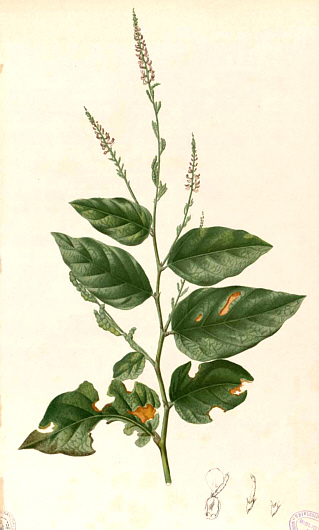

Zitierweise / cite as:
Carakasaṃhitā: Ausgewählte Texte aus der Carakasaṃhitā / übersetzt und erläutert von Alois Payer <1944 - >. -- Anhang A: Pflanzenbeschreibungen. -- Desmodium gangeticum (L.) DC. -- Fassung vom 2007-06-27. -- URL: http://www.payer.de/ayurveda/pflanzen/desmodium_gangeticum.htm
Erstmals publiziert: 2007-06-27
Überarbeitungen:
Anlass: Lehrveranstaltung SS 2007
©opyright: Dieser Text steht der Allgemeinheit zur Verfügung. Eine Verwertung in Publikationen, die über übliche Zitate hinausgeht, bedarf der ausdrücklichen Genehmigung des Verfassers
Dieser Text ist Teil der Abteilung Sanskrit von Tüpfli's Global Village Library
WARNUNG: dies ist der Versuch einer
Übersetzung und Interpretation eines altindischen Textes. Es ist keine
medizinische Anleitung. Vor dem Gebrauch aller hier genannten Heilmittel wird
darum ausdrücklich gewarnt. Nur ein erfahrener, gut ausgebildeter ayurvedischer
Arzt kann Verschreibungen und Behandlungen machen!
Falls Sie die diakritischen Zeichen nicht dargestellt bekommen, installieren Sie eine Schrift mit Diakritika wie z.B. Tahoma.
Verwendete und zitierte Werke siehe: http://www.payer.de/ayurveda/caraka0001.htm

Abb.: Desmodium gangeticum (L.) DC.
[Bildquelle: Wikipedia]
Dutt:
"DESMODIUM GANGETICUM, DC. Syn. Hedysarum Gangeticum. (Roxb.) Sans. Sālaparni. Vern. Sālpāni, Beng. Sarivan, Hind.
This little shrub is regarded as febrifuge and anti-catarrhal. It forms an ingredient of the compound decoction called dasamula kvatha, a combination much used in a great variety of diseases. Dasamula is made up of Desmodium Gangeticum (sālaparni), Uraria lagopodioides (prisniparni), Sotlnum Jacquinii (kantukāri), Solanum Indicum (vrihati), Tribulus terrestris (gokshura), Aegle Marmelos (vilva) Calosanthes indica (syonāka), Gmelina arborea (gambhāri), Stereospermum suaveolens (pātala) and Premna spinosa (ganikārikā),
The first five in the above list, are collectively called hrasva-pattcha mula or the five minor plants, and the last five are called vrihat pancha mula or the five major plants. A decoction of the hrasva pancha mula is used in catarrhal fever, cough and other diseases supposed to be caused by deranged phlegm. The vrihat pancha-mula is used in fever and other diseases supposed to be caused by deranged air. The ten drugs together are used in remittent fever, puerperal fever, inflammatory affections within the chest, affections of the brain and many other diseases supposed to be caused by derangement of all the humours.1 Another combination called Ashtādasānga pāchana consists of the ten drugs above mentioned, with the addition of the eight following, namely, chiretā, devadāru, ginger, tubers of Cyperus rotundus (mustaka), root of Picrorrhiza Kurroa (katuki), indrajava seeds, corriander, and fruits of Pothos officinalis. A decoction of these eighteen drugs is used in fevers of a severe type with drowsiness, delirium, picking of bed clothes, insensibility, and difficult breathing. A preparation of aconite and arsenic is generally given along with it.
Dasamula taila. This is an oil prepared with a decoction of the ten drugs above mentioned, and is much used as a cooling application in headache and other diseases. To prepare it take of the ten drugs, in all twelve seers and a half, water sixty four seers. Boil down to sixteen seers and strain. To the strained decoction add four seers of lemon juice, four seers of prepared sesamum oil and a seer of the usual aromatics and colouring agents in the form of a paste and boil them together."
[Quelle: Dutt, Uday Chand: The materia medica of the Hindus / Uday Chand Dutt. With a glossary of Indian plants by George King. -- 2. ed. with additions and alterations / by Binod Lall Sen & Ashutosh Sen. -- Calcutta, 1900. - XVIII, 356 S. -- S. 145f.]